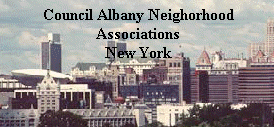UAlbany's neighbors feel out of the loop
Albany -- Some fear quality of
life will suffer as tech facilities move in
By KENNETH
AARON, Business
writer
First published: Saturday,
November 30, 2002
When Michael Miller starts telling his rugby buddies about how the
various nanotechnology projects at the University at Albany are going to
be bad for the neighborhood, they have a message for him.
Shut up.
He knows that news of new research-and-development centers being
opened by International Sematech and Tokyo Electron Ltd. is great from
an economic development standpoint. But he's afraid that traffic will
crawl to a halt in front of his home at 273 Fuller Road, which is
separated from the project near the corner of Fuller and Washington
Avenue Extension by a stand of trees.
Miller is worried that his house will be worth less as a result. And
he's not too happy that construction has pushed several of the
neighborhood's field mice into his attic, either.
While most of the Capital Region revels in the glow of promise
brought by Sematech and Tokyo Electron, both of which have announced
research-and-development projects worth more than $700 million at
UAlbany's Center for Environmental Sciences and Technology Management,
neighbors of the complex have concerns.
"My big issue is the quality-of-life thing," Miller said.
"No one's actually approached the people that live here, that are
actually going to be affected."
Don Reeb, a retired UAlbany economics professor who now is head of
the neighborhood's McKownville Improvement Association, said residents
frequently were overlooked because the mix of different municipal
jurisdictions makes communication difficult. While CESTM's land is in
the city of Albany, its neighbors live in Guilderland.
"It would be nice if somebody would tell somebody what's going
on," said Reeb, who is personally satisfied that the university is
taking environmental concerns to heart.
Guilderland town Supervisor Kenneth Runion said turf issues have been
a hot topic for years. Crossgates Mall, for example, is in the town yet
has regional effects. But it falls under local control, he said.
"What it does is it raises again what people have been talking
about for years: We need to get involved more with regional
planning," Runion said.
He suggested that because the project involves the state university,
Guilderland residents who have concerns should contact their elected
state legislators -- Sen. Neil Breslin or Assemblyman John J. McEneny.
UAlbany officials could not be reached for comment on the process.
Many of the McKownville group's members have peppered Reeb with
questions about the project, and their concern ranges from mild
curiosity to demands that work stop.
Most, though, would be satisfied with inclusion in the loop.
When the state held a public hearing two weeks ago to discuss a $50
million grant toward the project, about 70 people showed up and 20
spoke. None identified themselves as neighborhood residents, and only
one person said anything remotely resembling a word of caution about the
project.
Afterward, one neighbor, Don Csaposs, said he might have attended if
he had known there was a meeting. While the state placed a legal notice
in the Times Union alerting citizens of the hearing, Csaposs would have
preferred a more personal approach.
"Three hundred high-paying jobs plunked down into this area is,
in a global sense, never going to be a negative," said Csaposs, who
lives at 20 Norwood St., which is off Western Avenue. "But if we
bring 300 new, highly paid jobs into the area and in the process
marginalize a long-standing neighborhood that is the home to several
hundred residents, that is neither stressed or depressed ... we have
negatively impacted some folks."
Between Sematech and Tokyo Electron, more than 500 new jobs are
expected.
For the most part, those who are grumbling about the project now are
looking to have their own concerns managed.
"Work with us," said Miller, the Fuller Road resident. And
at the very least, he asked that Fuller Road be repaved, saying:
"It's a mess."
